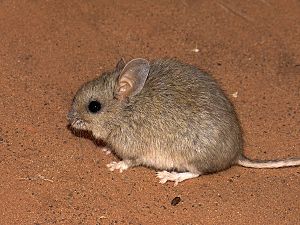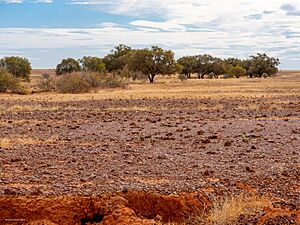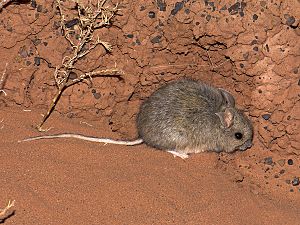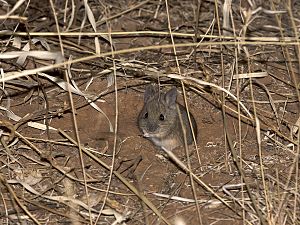Plains rat facts for kids
Quick facts for kids Plains rat |
|
|---|---|
 |
|
| near Mount Dare Station, South Australia Photography by Tim Bawden (2017) | |
| Conservation status | |
| Scientific classification | |
| Genus: |
Pseudomys
|
| Species: |
australis
|
 |
|
| The historical distribution (pre-1980) and assumed extant distribution (1980-2018) of the plains rat across Australia. | |
The plains rat (Pseudomys australis), also called the palyoora or plains mouse, is a small rodent that lives in the dry and semi-dry parts of Australia. Indigenous groups used to call it pallyoora or yarlie. This animal was once found across a wide area of central Australia.
However, its numbers have dropped a lot. This is because its home is being damaged by grazing animals, new predators, and dry weather. Because of this, the plains rat is now considered 'presumed extinct' in New South Wales and Victoria. It is 'endangered' in the Northern Territory and Queensland, and 'vulnerable' in Western Australia and South Australia. The International Union for Conservation of Nature (IUCN) lists the plains rat as 'vulnerable' because its population is still shrinking.
Contents
What's in a Name?
The scientific name for the plains rat is Pseudomys australis. The first part, Pseudomys, comes from two old words. Pseudes is a Greek word meaning "false," and mys is a Latin word meaning "mouse." This name was chosen because the plains rat looks a bit like a "true mouse" but is also different.
The second part, australis, is a Latin word meaning "south land." So, Pseudomys australis means 'false mouse from the southern land'. This name was first given by a scientist named Grey in 1832.
Scientists believe that the ancestors of the plains rat first arrived in Australia about 4.2 to 5 million years ago. They came from Southern Asia and slowly spread out into many different types of rodents. The plains rat belongs to a group called the Australo-Papuan Old Endemics.
The plains rat is part of the rodent family. It belongs to a group called Pseudomys. There are 13 different groups of native Australian rodents, and they live in different habitats. Pseudomys species, like the plains rat, usually live in dry and semi-dry areas.
Where Plains Rats Live
Today, plains rats are mainly found in five key areas. These are:
- The Arcoona Tableland in South Australia.
- The Southern Lake Eyre region in South Australia.
- The Moon Plain region in South Australia.
- The Oodnadatta region (including Witjira National Park) in South Australia and the Northern Territory.
- The Andado Station and Mac Clark Conservation Reserve in the Northern Territory.
These places often have lots of stones, small rocks, and natural dips in the ground that collect water. This is because the plains rat prefers to live on stone-covered plains.
In the past, plains rats lived in many different places, like river areas, grasslands, and sand dunes. But now, they are mostly found on stony plains called "gibber plains" (Figure 3) in central-northern South Australia. These areas have clay that cracks, and small streams that help plants grow. These plants include low shrubs and temporary grasses or herbs.
A single plains rat usually lives in an area of about 1.6 hectares. But sometimes, whole groups of plains rats might move outside their usual homes to find safe places during dry times. These safe places usually have more food and shelter. Also, if there's a lot of rain and their homes flood, they might temporarily move to other nearby areas.
What Plains Rats Look Like
The plains rat has a strong body and usually weighs about 65 grams. It has long ears and a round nose. Its fur is grey to brown on its back, and white or cream on its belly (Figure 4).
From its head to its body, it is usually between 90 and 145 millimeters long. Its tail is about the same length as its body. When a mother plains rat is feeding her babies, you might see her dragging them along. This happens because the babies hold onto one of her four teats on her belly.
Plains Rat Behavior and Life Cycle
Plains rats dig a complex network of shallow tunnels under the cracking clay of the stony plains. They only come out at night to find food. They eat seeds, plant stems, and small insects.
During times when they are not breeding, both male and female plains rats live together in groups of up to 20 individuals. But during breeding season, one male will live in a burrow with up to three females. Males can become quite restless during this time. Both males and females are known to stand on their back legs and squeal loudly if they feel threatened.
Plains rats don't have a specific breeding season. They usually start having babies after they are 8 to 10 weeks old. The mother carries the babies for about 30 to 31 days before they are born. A mother plains rat usually has four babies at a time, but she can have up to seven.
The plains rat usually lives for about two years. However, how long they live often depends on how much food and water is available. If there are many years of good rainfall, they can live up to 4.5 years. But during very dry periods, most plains rats will only live for one year.
Threats to Plains Rats
The plains rat faces several dangers that threaten its survival. These include damage to its habitat, new predators, and dry weather.
Habitat damage mostly comes from farm animals with hooves, like cattle, and from land being cleared. Hoofed animals eat too much vegetation, crush the seeds in the ground, and trample the plains rats' burrows. Clearing land removes important food sources for the plains rat.
When there is less plant cover and damaged burrows, it becomes easier for predators like the European fox (Vulpes vulpes) (Figure 5) and feral cat (Felis catus) to dig up the shallow burrows. This can cause plains rat populations to disappear from certain areas, especially when their numbers are already low during droughts.
Other possible threats to the plains rat include changes in how often bushfires happen, which can lead to more intense fires. They also face competition for food and space from introduced animals like the house mouse (Mus musculus) and the European rabbit (Oryctolulus cuniculus). Climate change is also a concern.
How We Can Help
The Action Plan for Australian Mammals 2012 has three main goals to help the plains rat. These goals are:
- To manage the threats so that the plains rat population can grow or stay stable.
- To protect the groups of plains rats that are known to exist.
- To find and protect places where plains rats can go for safety during dry times.
The 2012 National Recovery Plan for the Plains Mouse encourages everyone to work together. This includes local communities, governments, and businesses. By working together, we can help protect the plains rat (Figure 6).








